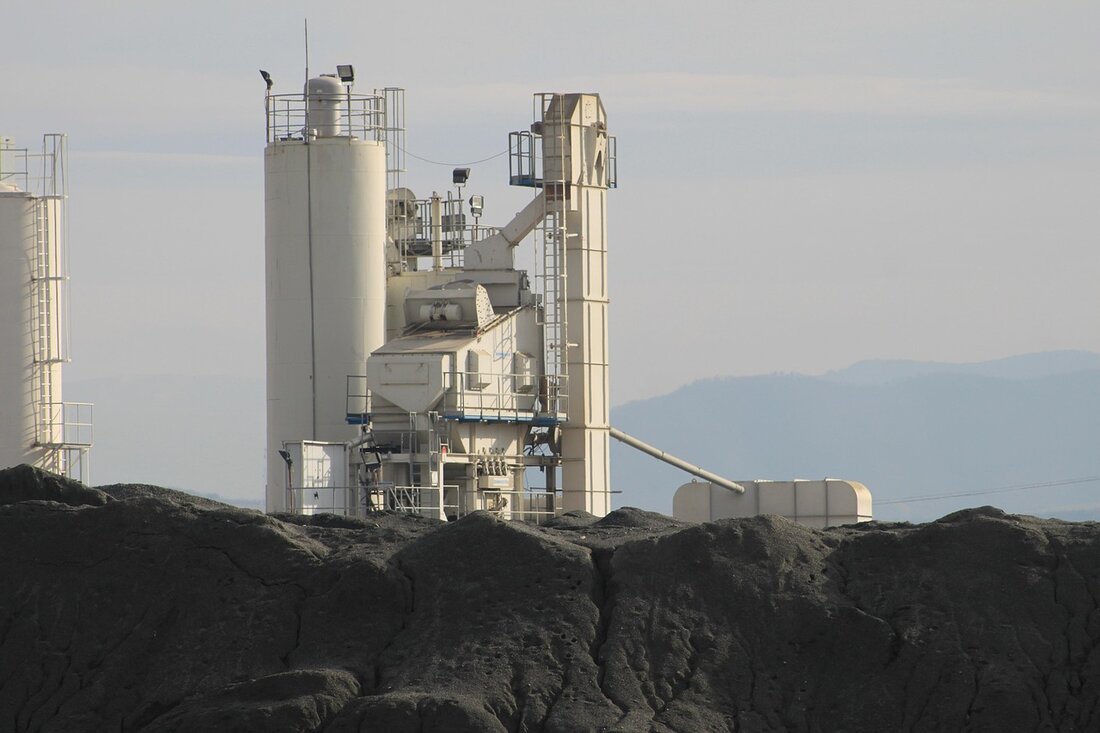Raw materials in focus: How lithium and water are igniting global politics!
The article analyzes how raw material deposits such as lithium, rare earths and water resources shape the geopolitics of the 21st century and intensify international tensions.

Raw materials in focus: How lithium and water are igniting global politics!
In the 21st century, natural resources have become a central factor in geopolitics, providing the basis for economic power, technological innovation and national security. The growing demand for strategic resources such as lithium, rare earths and water is not only driving global competition, but also fueling international tensions. These raw materials are essential for the energy transition, digitalization and basic services - but their unequal distribution and limited availability make them a geopolitical flashpoint. As states fight for control and access, new alliances and conflicts emerge that are redefining the global order. This article examines how these resources shape international relations and what challenges they pose for the future.
Raw material occurrence and their geopolitical meaning

In the 21st century, key resources such as lithium, rare earths and water play a crucial role in geopolitics as they form the basis for technological innovation, economic development and national security. These raw materials are not only essential for the energy transition and digitalization, but also for the basic supply of populations. However, their unequal distribution and limited availability make them a central factor in international tensions. While lithium and rare earths ensure industrial and technological dominance, water is a vital resource whose scarcity exacerbates conflicts. Control over these resources increasingly determines the balance of power between states and shapes global alliances and rivalries.
Lithium, an alkali metal from group 1 of the periodic system, is an indispensable part of the modern energy industry. With a melting point of 180.5 ° C and a specific density of 0.534 at 20 ° C, it is the lightest metal and is mainly used in rechargeable batteries for electric vehicles and electronic devices. Lithium deposits are not extremely rare in the earth's crust (approx. 0.002 %), but economically exploited deposits are concentrated on a few countries such as Australia, Chile and Bolivia, the latter having the largest reserves, but only a low production. Production is usually made from salt lakes or minerals such as spodums, which makes the process complex and environmentally stressful. Geopolitically, the high demand for lithium leads to a competition for resources, especially between industrialized nations such as the USA, China and the EU, which want to reduce their dependence on imports. Further information on the chemical properties and occurrence of lithium can be found Britannica.
Rare earths, a group of 17 chemical elements including Scandium, Yttrium and the Lanthanoids, are not necessarily rare despite their name in the earth's crust - some are more common than lead or copper. Nevertheless, economically exploited deposits are limited, and their elaborate separation makes the extraction expensive and environmentally stressful. China dominates the worldwide production (2022: approx. 60 %) with the Bayan OBO mine as a central location, while other countries such as Australia (Mount Weld) or the USA (Mountain Pass) try to reduce its dependency. Rare earths are indispensable for high technologies such as magnets in wind turbines, screens and medical devices, which underlines their strategic importance. The increasing demand through digitization and energy transition increases global competition, while environmental problems such as poisonous mud and radioactive waste create additional challenges. The geopolitical tensions are further fueled by China's export restrictions and efforts to build up alternative supply chains. Detailed insights into the occurrence and production offers Wikipedia.
Water resources are another key resource, the geopolitical importance of which has increased dramatically in the 21st century due to climate change and population growth. While lithium and rare earth primarily fuel industrial conflicts, water is about the existential securing of life and agriculture. In regions such as the Middle East or Central Asia, where cross -border rivers such as the Nile or the AMU Darya run, water shortages and unequal distribution lead to tensions between countries. Egypt and Ethiopia are, for example, in a long -term conflict about the Grand Ethiopian Renaissance Dam, who influences the water flow of the Nile. Such arguments show how water can become a weapon as a strategic resource, be it through dam projects or the control of trusses. Unlike lithium or rare earths, there are no global supply chains, but local and regional power struggles, which are often difficult to solve through international mediation.
The analysis of these key resources makes it clear that in the 21st century, raw materials are much more than just economic goods - they are instruments of power. Lithium and rare earths determine technological and industrial dominance, while water determines life and death. The unequal distribution of these resources leads to global competition that promotes both cooperation and conflict. Countries with significant reserves are gaining geopolitical influence, while import-dependent countries are seeking diversification and alternative strategies. This competition shapes not only bilateral relationships, but also international organizations and agreements that attempt to defuse resource conflicts. The future of geopolitics will largely depend on how sustainably and fairly access to these resources can be regulated.
Lithium and the future of electromobility

Lithium plays a central role in the global energy transition in the 21st century, as it is an essential component of lithium-ion batteries used in electric vehicles, portable electronics and renewable energy storage systems. A soft, silvery-white alkali metal with atomic number 3 and a density of just 0.534 g/cm³ - the lowest value of all solid elements - lithium is ideal for lightweight, high-performance batteries. Growing demand for clean energy solutions has dramatically increased the need for lithium since World War II, driving up both production and prices. But this central role in the energy transition also brings with it significant geopolitical tensions, as the resource is unevenly distributed and its extraction poses complex challenges. For detailed information on the properties and applications of lithium see Wikipedia.
The largest lithium reserves are located in the so-called "lithium triangle" in South America, which includes Chile, Bolivia and Argentina, as well as in Australia. Chile and Australia are currently the leading producers, while Bolivia only plays a subordinate role despite the world's largest reserves due to political instability and infrastructural difficulties. This concentration of the occurrence creates strategic dependency for industrialized nations such as the USA, China and the European Union, the lithium needs for its energy transition and industrial production. China has secured a dominant position through investments in South American mines and processing capacities, which reinforces tensions with western states that want to diversify their supply chains. The competition for access and control over lithium resources has led to a new form of raw material diplomacy in which economic and political influence go hand in hand.
The extraction of lithium also poses significant ecological and social challenges that further exacerbate geopolitical conflicts. Mining, particularly from salt lakes in arid areas such as the Atacama Desert in Chile, uses enormous amounts of water, threatening local communities and ecosystems. This creates tensions between governments, international corporations and indigenous groups whose livelihoods are threatened by extraction. Human rights issues, such as the rights of indigenous peoples and conflicts between artisanal and large-scale industrial mining, are increasingly the focus of international criticism. These problems not only complicate production, but also influence relationships between resource-rich countries and importing states, which are under pressure to establish sustainable and ethical supply chains.
Another aspect of the geopolitical tensions is the price development and market dynamics of lithium. Strong demand for lithium-ion batteries has led to significant price fluctuations, creating challenges for both producers and consumers. While high prices strengthen countries like Chile and Australia economically, they put pressure on import-dependent nations to find alternative technologies or sources of supply. At the same time, large players like China use their market position to influence prices and availability, which can marginalize smaller or less developed producers. These economic imbalances increase geopolitical rivalry and encourage protectionist measures, such as export restrictions or subsidies for domestic industries, which further complicate global trade.
In addition to industrial applications, lithium also has historical significance in medicine, particularly in the treatment of bipolar disorder, highlighting its versatility. However, there are risks associated with medical use such as toxicity, which can have serious health consequences if handled improperly. Although these aspects are not directly linked to the energy transition, they illustrate the broad relevance of the element. For further information on the medical uses and risks of lithium Webmd valuable insights. In the geopolitical context, however, the focus remains on lithium as a key resource for the energy transition and the associated tensions between states that are struggling for technological and economic predominance.
In summary, it can be said that lithium plays an indispensable role in the global energy transition, but is also a focus of geopolitical conflicts. The concentration of resources in a few countries, combined with ecological and social challenges, creates a complex network of dependencies and rivalries. While the demand for lithium continues to increase, the competition for this strategic resource will further shape international relations. The ability to develop sustainable extraction methods and diversify supply chains will be crucial to defuse tensions and to ensure a fairer distribution of the advantages of this key resource.
Rare earth as strategic resources

In the 21st century, the trade in rare earths has created a complex network of dependencies and power relations that significantly shapes the geopolitical landscape. Despite their misleading name, rare earths, a group of 17 chemical elements including scandium, yttrium and the lanthanides, are not necessarily rare in the Earth's crust - some are more common than lead or copper. But economically exploitable deposits are limited, and their complex separation makes extraction expensive and environmentally damaging. These resources are essential for key technologies such as wind turbines, electric motors and electronic devices, underlining their strategic importance. Global demand, driven by digitalization and the energy transition, has increased dependence on a few producers and shifted the balance of power in favor of these countries. For detailed information on the properties and occurrence of rare earths Wikipedia comprehensive insights.
China plays a dominant role in this context as it has the largest economically mineable reserves, particularly in the Bayan Obo mine, and has long controlled the world market. In 2014, China's share of global production was 97.5%, although this fell to around 60% by 2022. This market dominance has led to a strong dependency of many industrialized nations, particularly the European Union, which imported around 98% of its rare earth requirements from China in 2020. This dependence gives China considerable geopolitical influence, as it can exert pressure on other states through export restrictions - as introduced in 2010. Such measures have heightened international tensions and prompted countries such as Japan and the EU to look for alternative sources of supply and strategies to secure supplies.
The balance of power caused by the trade in rare earths are not only economical, but also political in nature. China's ability to control access to these resources has made it a central player in global supply chains, which brings western states into a defensive position. The 2010 export restrictions led to a price increase and forced countries to rethink their dependency. For example, Japan invested in recycling technologies and alternative, while the United States revived the dismantling in Mountain Pass Mine in California. Nevertheless, the dependence on Chinese processing capacity remains, since the separation of the chemically similar elements outside of China is often uneconomical. This underlines how rare earths can be used as geopolitical pressure in order to force political concessions or to secure economic advantages.
New discoveries and diversification efforts could change the balance of power in the future, but challenges remain great. Recent discoveries, such as those in Kiruna, Sweden, by the company LKAB, raise hopes of reduced dependence on China. However, mining there could take 10 to 15 years and the economic viability remains questionable as production costs in Europe are high compared to Chinese imports. In addition, deposits in countries such as Australia (Mount Weld), Greenland and Canada are promising, but mining is often associated with environmental problems, including high greenhouse gas emissions and radioactive residues during separation. These ecological and economic hurdles make it difficult to become independent from China in the short term. Further information on the environmental consequences and the importance of rare earths can be found at Rnd.
The dependencies in the trade with rare earths also have an impact on international cooperation and conflicts. While the EU and other regions try to secure their supplies through funding programs and partnerships with countries such as Australia and Canada, the global supply chain remains fragile. Mining and processing are not only technically demanding, but also politically sensitive as they often conflict with environmental standards and local interests. Countries with reserves are gaining geopolitical weight, but must weigh up whether they use their resources for export or for their own industrial development. This dynamic creates a tension between resource exporters and importers that further complicates the international order.
In summary, the trade in rare earths illustrates how raw materials are becoming a central element of geopolitical power in the 21st century. China's dominance has created an imbalance that puts other states in a dependent position while providing incentives for diversification and innovation. The power dynamics created by this resource are dynamic and could shift with new deposits or technological advances. However, the challenge remains to find a balance between economic interests, environmental sustainability and geopolitical stability to minimize conflict and ensure a fairer distribution of benefits.
Water resources in global conflict

Water scarcity and the unequal distribution of water resources represent one of the most serious geopolitical challenges in the 21st century. While raw materials such as lithium and rare earths primarily fuel industrial and technological conflicts, water is about the existential security of life, agriculture and economic stability. Climate change, population growth and increasing industrialization are increasing pressure on already limited freshwater resources, leading to tensions between states in many regions. Particularly in water-scarce areas such as the Middle East, North Africa and Central Asia, transboundary rivers and aquifers are becoming strategic resources whose control can trigger political and military conflicts. This dynamic shows how water is being used as geopolitical leverage and redefining the balance of power between countries.
A prominent example of the geopolitical tensions due to water shortages is the conflict for Nile in North Africa. Egypt, which is historically heavily dependent on the NIL, sees its water supply threatened by the construction of the Grand Ethiopian Renaissance Dam (Gerd) in Ethiopia. The dam that builds up the blue Nile could significantly reduce the water flow to Egypt and thus endanger agriculture and drinking water supply from millions of people. Despite international mediation efforts, among other things through the African Union, the dispute remains unsolved and has the potential to escalate into an open conflict. This case illustrates how water shortages not only threatened local, but also regional stability and burdened the relationships between countries that rely on the same resources.
In Central Asia, the unequal distribution of water from the Amu Darya and Syr Darya is creating similar tensions. Downriver countries like Uzbekistan and Turkmenistan rely on the water for their agricultural economies, while upstream countries like Tajikistan and Kyrgyzstan build dams to generate energy. These projects reduce water flow to low-lying regions and exacerbate shortages, especially in dry years. The lack of regional cooperation and the historical tensions between these countries make fair distribution difficult and lead to a latent potential for conflict, which is further increased by climate change. Here, water becomes a strategic resource whose control means political power.
The global dimension of the water shortage is also evident in the economic and social stress it causes. In many countries, the lack of water leads to migration, social unrest and economic decline, which in turn increases cross -border tensions. In the Middle East, a region that is characterized by political instability anyway, water shortages exacerbates existing conflicts. The Euphrate-Tigris Basin conflict between Turkey, Syria and Iraq is another example in which dam projects and different usage claims lead to diplomatic crises. Turkey controls the water flow through its dams, which brings downstream countries like Iraq into a dependent position and increases the tensions in an already fragile region. Insights into the economic consequences of geopolitical tensions, including those triggered by resources such as water, offers Thomas H. Stütz.
The challenges of water shortages are not only limited to developing countries, but also affect industrialized nations, albeit in a different form. In Germany, for example, the long-term potential water reserve bid is around 176 billion cubic meters (1991-2020), but even here there are declines, and the water use index is 10.1 % of the available presentation (2022). While this is still below the threshold of 20 %, which is considered water stress, it shows that even wealthy countries are not immune to the effects of climate change and increasing demand. The use of water in sectors such as energy supply (38.6 % of the withdrawals) and agriculture illustrates the economic importance of this resource. Further data on water use and the associated challenges in Germany can be found in the Federal Environment Agency.
In summary, it can be said that water shortages and distribution in the 21st century have become a central geopolitical conflict factor. In contrast to other raw materials such as lithium or rare earths, in which global supply chains play a role, water disputes are often regionally and deeply rooted in historical and political tensions. Control over rivers and aquifers becomes the question of power and survival, which makes diplomatic solutions difficult. Without international cooperation and sustainable resource management strategies, there is a risk of escalation of conflicts that could not only destabilize local populations, but also entire regions. The future of geopolitics will depend significantly on how states deal with this existential challenge.
Raw material security and national interests

Securing raw material reserves has become a central strategy for states in the 21st century to ensure their economic stability and national security. Raw materials such as lithium, rare earths and water are not only essential for industrial development and technological progress, but also for the basic supply of populations. The unequal distribution of these resources around the world is forcing countries to take targeted measures, be it through diplomatic alliances, economic investments or protectionist policies. These strategies have far-reaching implications for international relations, encouraging both cooperation and conflict and redefining global balances of power. Competition for raw materials increases geopolitical tensions while states simultaneously try to minimize their dependencies and assert their interests.
A common strategy for securing raw material deposits is the diversification of supply chains and the structure of strategic partnerships. Countries like China have secured their care through massive investments in African and South American mines - especially for lithium and rare earths - at the same time. This policy creates dependencies for low -resources, like many in the European Union, which then develop their own strategies to diversify their care. For example, the EU has closed partnerships with countries such as Australia and Canada to improve access to rare earths and reduce the dependency on China. However, such measures often lead to tensions because they tighten the competition for limited resources and challenge existing balance of power.
Another approach is to promote domestic resources and the development of alternative technologies. States with their own occurrence, such as Chile and Bolivia in the case of lithium, use their position to achieve economic and political advantages by controling export conditions or prices. At the same time, countries such as the USA and Japan are investing in recycling technologies and substitutes in order to reduce their dependence on imports. These strategies have direct effects on international relationships because they can promote protectionist tendencies and trigger trade conflicts. For example, China's export restrictions for rare earths have led to diplomatic crises in the past that have burdened global trade and cooperation.
Securing water resources represents a particular challenge because it often crosses borders and fuels regional conflicts. Countries like Turkey or Ethiopia use their geographical location to control the flow of water through dam projects, which puts downstream nations like Iraq or Egypt in a dependent position. Such strategies lead to geopolitical tensions as they pose existential threats to the countries concerned. International agreements and mediation efforts, as in the case of the Grand Ethiopian Renaissance Dam, often have limited success because national interests take precedence. This shows how securing water resources has not only economic but also security dimensions that can endanger regional stability.
The orientation towards national interests plays a central role in securing raw materials and influences the foreign policy of many states. As Klaus von Dohnanyi argues in his book “National Interests”, countries like Germany and the EU should align their policies more closely with their own needs instead of subordinating themselves to the interests of other powers, especially the USA. This view emphasizes the need to secure strategic resources independently of global alliances in order to avoid geopolitical dependencies. Dohnanyi's criticism of current foreign policy and his call for a more pragmatic stance illustrate how resource strategies are closely linked to the definition of national interests. Provides further insight into his argument Wikipedia.
The impact of these strategies on international relations is complex. On the one hand, they promote the formation of new alliances, such as between the EU and resource-rich countries, to secure common interests. On the other hand, they exacerbate conflicts, especially when states use their raw materials as a means of pressure or take protectionist measures. The tensions between China and Western states over rare earths or the conflicts over water in the Middle East show how raw material strategies influence the global order. In his analysis, Dohnanyi also criticizes values-based foreign policy, which could hinder pragmatic solutions, and advocates rapprochement with countries like Russia in order to defuse geopolitical tensions - an approach that could also be applied to raw materials cooperation. For an in-depth discussion of his positions see Deutschlandfunk Culture.
In summary, it can be said that the strategies for securing raw material reserves are a central factor in the geopolitics of the 21st century. They shape international relationships by creating dependencies, promoting competition and the need for cooperation. While states protect their national interests through diversification, investment and control over resources, the balance between self-interest and global cooperation remains a challenge. The future will depend on whether it is possible to develop sustainable and fair mechanisms that minimize conflicts and ensure access to strategic raw materials for all.
Technological innovations and dependence on raw materials

Technological developments in the 21st century increased the demand for critical raw materials such as lithium and rare earths and thus fundamentally changed the geopolitical landscape. The rapid progress in areas such as renewable energies, digitization and artificial intelligence (AI) require enormous amounts of specific resources that are indispensable for the production of batteries, magnets and electronic components. This interaction between technological innovation and raw material requirements creates new dependencies and competitive dynamics between countries, since control over these materials becomes a strategic advantage. At the same time, geopolitical tensions drive the search for alternative technologies and sources of delivery, which further accelerates the innovation cycles. This complex interaction shapes international relationships and presents states with the challenge of reconciling technological progress with resource security.
A key driver of demand for critical raw materials is the energy transition, which is driven by technological innovations such as solar energy, wind power and electromobility. Lithium-ion batteries, essential for electric vehicles and energy storage systems, have exploded the demand for lithium in recent decades. Countries such as Chile and Australia, which have significant reserves, are gaining geopolitical influence, while import-dependent nations such as the USA and the EU are coming under pressure to secure their supply chains. This dependence creates tensions as states compete for access to these resources while investing in technologies that could reduce raw material consumption, such as alternative battery chemistries. For a comprehensive definition and examples of technological innovations IdeaScale valuable insights.
Equally important is the role of rare earths, which are essential for high technologies such as magnets in wind turbines, screens and AI-supported systems. Digitalization and the use of artificial intelligence, which require enormous computing power and specialized hardware, have further fueled the demand for these materials. China, which dominates the global market for rare earths, is using this position to exert geopolitical pressure, such as through export restrictions such as those introduced in 2010. This has led Western countries to invest in recycling technologies and alternative sources to reduce their dependence. The interaction between technological progress and demand for raw materials is particularly clear here: innovations increase demand, while geopolitical tensions drive the development of new technologies to save resources.
The social and economic effects of these technological developments further increase the geopolitical challenges. Technological innovations promote economic growth and create new markets, but also change the labor landscape through automation and digitization. Companies and states that invest in new technologies can increase their productivity and reduce costs, which gives them a competitive advantage. But this progress is bound to access to critical raw materials, which disadvantages low -resources and exacerbates global inequalities. The digital gap - the unequal access to technologies - is further influenced by the availability of raw materials, since countries remain without resources or processing capacities. Further details on the social effects of technological innovations can be found EJW-Exbi.
Geopolitically, the high demand for critical raw materials is leading to a reorganization of alliances and conflicts. Countries like China and Russia that have significant reserves or processing capacity are gaining influence, while Western nations are seeking diversification. Technological innovations such as 3D printing or cloud computing, which open up new production and communication channels, could change the need for certain raw materials in the long term, but in the short term the dependence remains. This dynamic creates a race between technological development and geopolitical strategy: While innovations increase demand for raw materials, geopolitical tensions force states to invest in alternative solutions. The conflict over rare earths between China and Japan shows how closely these interactions are linked to international tensions.
Another aspect is sustainability, which is both promoted and challenged by technological developments. Innovations in renewable energy are aimed at more environmentally friendly practices, but the extraction of raw materials such as lithium or rare earths is often environmentally harmful. This leads to a tension between the goal of the energy transition and the ecological costs of raw material extraction, which in turn fuels geopolitical debates about responsibility and resource management. Countries with strict environmental regulations, such as the EU, face the challenge of balancing their technological ambitions with sustainable supply chains, while other nations use less restrictive standards to strengthen their market position.
In summary, looking at the interactions between technological developments and the demand for critical raw materials illustrates how closely innovation and geopolitics are linked. Technological advances are driving the need for resources such as lithium and rare earths, while geopolitical tensions are accelerating the search for alternatives and the diversification of supply chains. This dynamic shapes international relationships through new dependencies and competitive structures. The future will depend on whether states and companies manage to design innovations in such a way that they can overcome technological as well as geopolitical and ecological challenges.
Sources
- https://www.britannica.com/science/lithium-chemical-element
- https://de.wikipedia.org/wiki/Metalle_der_Seltenen_Erden
- https://en.m.wikipedia.org/wiki/Lithium
- https://www.webmd.com/vitamins/ai/ingredientmono-1065/lithium
- https://de.m.wikipedia.org/wiki/Metalle_der_Seltenen_Erden
- https://www.rnd.de/wissen/seltene-erden-was-ist-das-und-wofuer-werden-sie-gebraucht-DUUTMEHKUZBZ3HICISFR56YM5I.html
- https://www.umweltbundesamt.de/daten/wasser/wasserressourcen-ihre-nutzung
- https://thomas-h-stuetz.eu/geopolitische-spannungen-und-ihre-auswirkungen-auf-globale-maerkte-unternehmen-wissen-muessen-02/
- https://de.wikipedia.org/wiki/Nationale_Interessen
- https://www.deutschlandfunkkultur.de/dohnanyi-nationale-interessen-buchkritik-100.html
- https://ideascale.com/de/der-blog/was-ist-technologische-innovation/
- https://ejw-exbi.de/technologische-innovationen-und-ihre-auswirkungen-auf-die-gesellschaft/

 Suche
Suche
 Mein Konto
Mein Konto